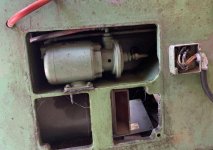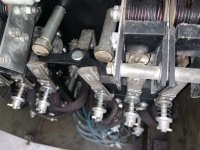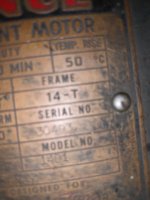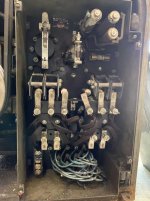You say that the speed control pot controls the motor in reverse. What, if anything, happens in forward? You'll want to look carefully at the wire tags on the terminals at the bottom of the DC panel and on the MG terminal panel and see if any are out of place.[/QUOTE
Cal, I have the issue sorted. Turned out to be miswired armature wires to the motor, in the small box on the motor. Here is a photo before I swapped armature leads:

After swapping, the lathe runs smooth and accelerates in fwd. as expected. I took it to 4000 RPM and it was very cool to see it make it. The last few RPM took a few seconds, it kind of creeped upwards from 3800 to 4000. Deceleration worked great, so the braking resistors are working. I tried the back gear, and it worked but it complained a bit at the high end. Anyway, enough electrical testing for now, I plan to work on the mechanical end of things now.
I'll e-mail you a copy of my color-coded version of EE-3216; it's a lot easier to trace things on that version.
Thanks Cal, much appreciated.
As I'm sure you know, you can buy brushes from Monarch. The
Helwig Carbon R1017 brushes that Monarch sold me for my 1943 machine are the same ones used for your square-dial, Reliance model 14D1, 3HP DC motor. My 1943 round-dial's motor doesn't have a model number marked on the data plate, but it's also a frame 14-T Reliance motor; instead it's marked with and E/S number: 161-EC-15. All three brush sets for my 1943 machine are different.
I plan to do that Monday, also order a manual and inquire about way wipes and parts for the turret.
You'll want to replace the three resistors in the upper-right corner of the DC panel. Those are a common failure item on square-dials (the exciter being the only other). See this link:
Start up problem with m/G machine?
It looks like you have part of a Monarch factory lever-operated 5C collet closer, but I don't see the lever anywhere.
Cal
I will look for replacement resistors too, thanks for the suggestion. The 5C collet closer was missing, but I had one available, so it will get installed on the machine.
Dave






























